Punjabi Sarson ka Saag, served with Makki ki roti, is a classic North Indian winter favorite. This traditional saag, packed with flavor and nutrition, is a comforting and hearty meal. Learn how to make authentic Sarson ka saag with my mom’s perfect recipe.

Easy Saag Recipe
Sarson ka Saag and Makki ki roti are a winter staple meal in North India. Saag is made with mustard greens that are mainly available during the winter season in India.
I have been wanting to make Saag for Lohri for a long time. So, I called my mom for her authentic recipe. She shared all her tips to make the perfect Punjabi saag, and here it is for you all to try!
I have, of course, included the method to make saag in the instant pot and stovetop, similar to my chicken saag and saag paneer recipe. You can pressure cook the greens or cook them in a pot on the stovetop if you want to make it the traditional way.
Some more winter favorite Indian recipes you will love: gajar halwa, aloo methi, and methi paratha.
Table of Contents
- Easy Saag Recipe
- Watch How to Make Sarson ka Saag
- What is Saag? What is Sarson ka Saag?
- Where to Find Mustard Greens?
- What other greens can be used to make Saag?
- Saag Ingredients
- How To Make Saron ka Saag?
- Pro-Tip for Amazing Saag
- What to Serve with Sarson Ka Saag?
- How to Store Saag?
- Can You Freeze Sarson ka Saag?
- Common Questions
- More Punjabi Recipes You’ll Love
- Sarson ka Saag (Authentic Punjabi Saag Recipe) Recipe
Watch How to Make Sarson ka Saag
What is Saag? What is Sarson ka Saag?
The word Saag means vegetable greens. In the context of curry, Saag is used to describe blended or puréed spiced greens. Saag can be made with a variety of greens, but mustard greens and spinach are the most popular choices.
Sarson in English is basically mustard greens. Sarson ka saag is a mustard greens curry. This saag is one of the most popular recipes in Punjabi cuisine.
Sarson (Mustard greens) have a slightly bitter taste. Hence, they are cooked along with other greens that balance the flavors of the final dish. Typical greens used are – Bathua (Chenopodium), methi (fenugreek leaves), turnip leaves, and spinach.
This curry is mildly spiced, where the greens’ flavors are the dish’s highlight. The greens make the sarson ka saag not just a delicious dish but also very nutritious. It is a rich source of fiber and vitamins such as K and C and disease-fighting antioxidants.
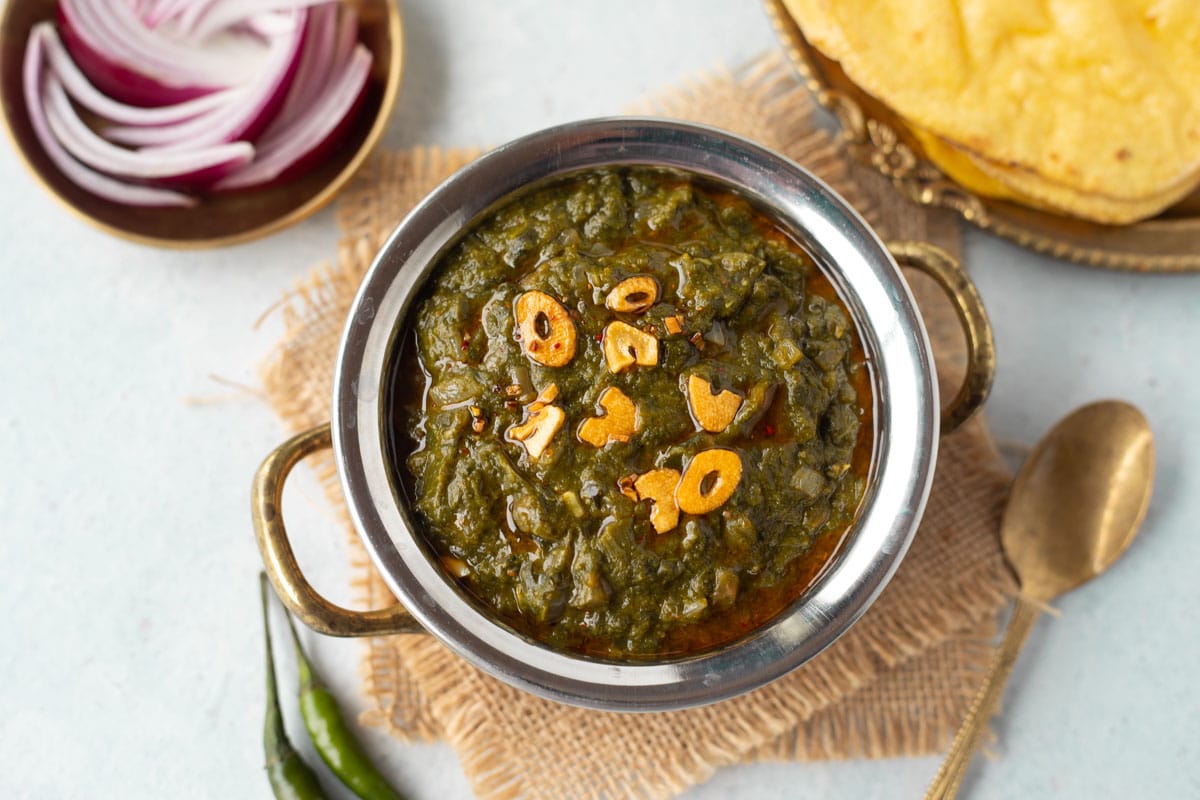
Where to Find Mustard Greens?
Sometimes, I am able to find mustard greens at the local Indian grocery store. If you can’t find them at the Indian grocery store, Asian grocery stores often carry mustard greens too.
If you can’t find mustard greens, use Rapini, which is the closest in taste.
I use a ratio of 2:1 for mustard greens to other greens, So basically, 2 parts of mustard greens and 1 part of other greens. I want the taste of mustard to shine in this dish; hence, I use less of the other greens. But feel free to adjust to 1:1 based on your preference.
What other greens can be used to make Saag?
If you can’t find mustard greens, below are some options:
- Broccoli Rabe (Rapini): My local Indian and American grocery stores always carry rapini. I have tried these for Saag, and they work very well.
- Bathua (Chenopodium)
- Turnip Greens
- Kale
- Collard greens
- Methi (fenugreek leaves)
- Spinach
I suggest using a variety of greens when making saag. It is a great way to include all the wonderful greens in your diet.
Saag Ingredients
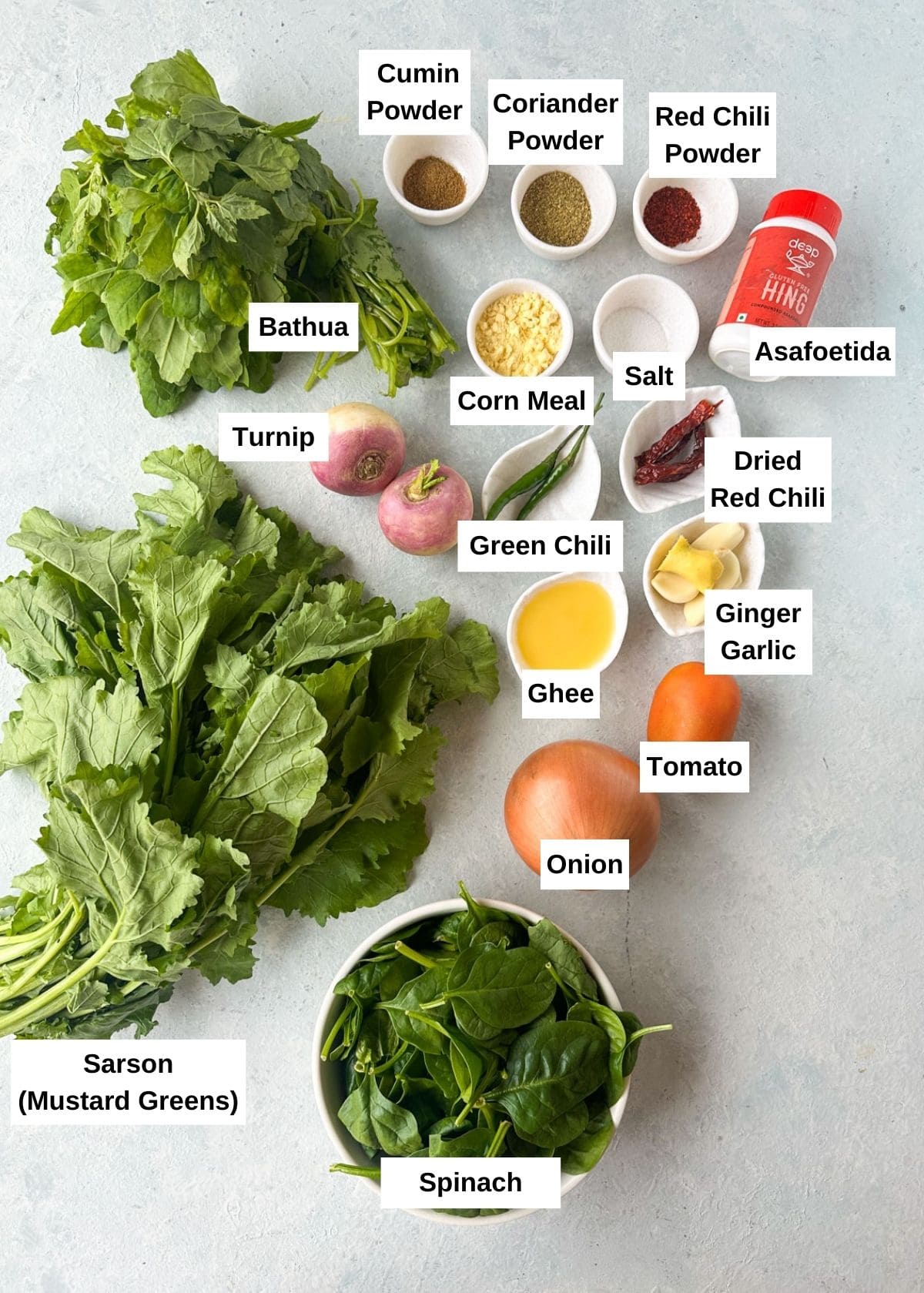
- Mustard Greens: They are the highlight of this dish. I like to use fresh leaves whenever I can find them. If you can’t find fresh, frozen is an option too.
- Other Greens: I used Bathua (Chenopodium) and Spinach. Baby spinach can also be used.
- Turnip: I added 2 small turnips to this saag, which add a mildly sweet taste to the dish once cooked. You can also use white radishes if you don’t have turnips on hand.
- Green Chili Peppers: They add the heat to the dish. I suggest using a good amount as we use only a few other spices when making this dish.
- Ghee/Oil: I use ghee when making saag. To make it vegan, you can use oil as well.
- Onion: I like to add onion when making the tempering for the saag. I use yellow onions, but red onions will work fine too.
- Ginger and Garlic: Use grated ginger and minced garlic. You can also use paste if you prefer.
- Tomato: Some people like to make saag without any tomatoes. My mom suggests to include one tomato in it.
- Spices: Coriander and cumin powder are mainly used in this saag. I like adding some red chili powder for a little spice, but this is optional. My mom says cumin seeds and turmeric are not added to saag.
- Cornmeal / Maize Flour / Makki ka Aata: This binds the saag and prevents the water from separating from the greens. Use fine cornmeal here. It is the same flour used to make makki ki roti, the perfect accompaniment to this dish. In India, it is typically called yellow corn flour. But note that this is not the same as the white cornflour/cornstarch used to thicken soups or Chinese dishes. If you can’t find maize flour, substitute with the same amount of gram flour (besan).
How To Make Saron ka Saag?
This recipe is quite easy to make. The main time and effort is spent cleaning and chopping the greens.
Clean and Chop the Greens
- Start with cleaning the greens, as there can often be a lot of dirt within the bunch of leaves.
- For the mustard greens (or rapini if using), remove just the hard stems at the bottom. The soft stems (called gundal in Punjabi) are usually chopped and included to make the saag. I usually chop these greens small, about 1 cm apart, so they cook easily. Mustard greens take longer to cook compared to spinach leaves.
- For bathua, you want just to include the leaves. Pluck the leaves and set aside.
- Remove the hard stems of spinach and chop it roughly. You can also use baby spinach leaves.
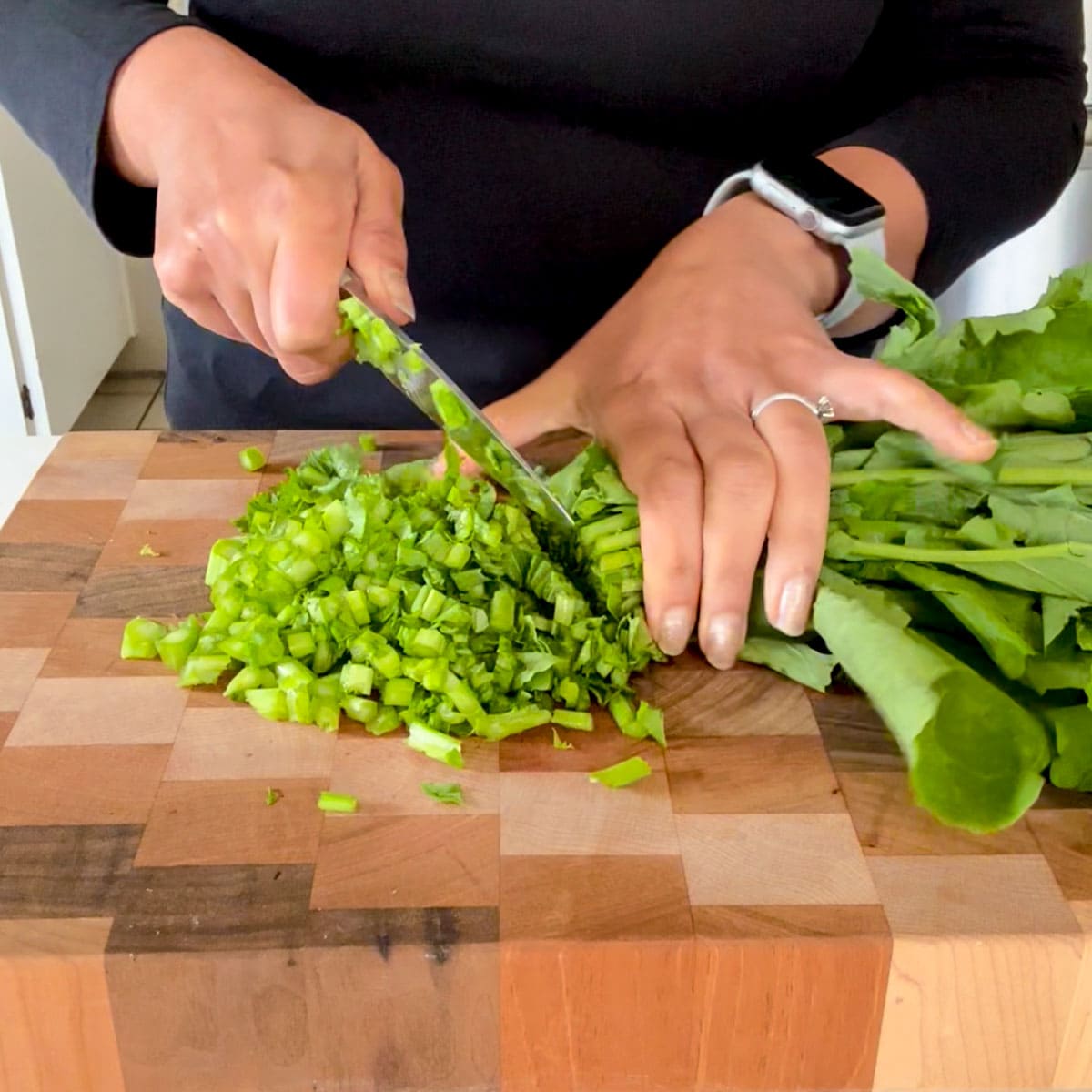
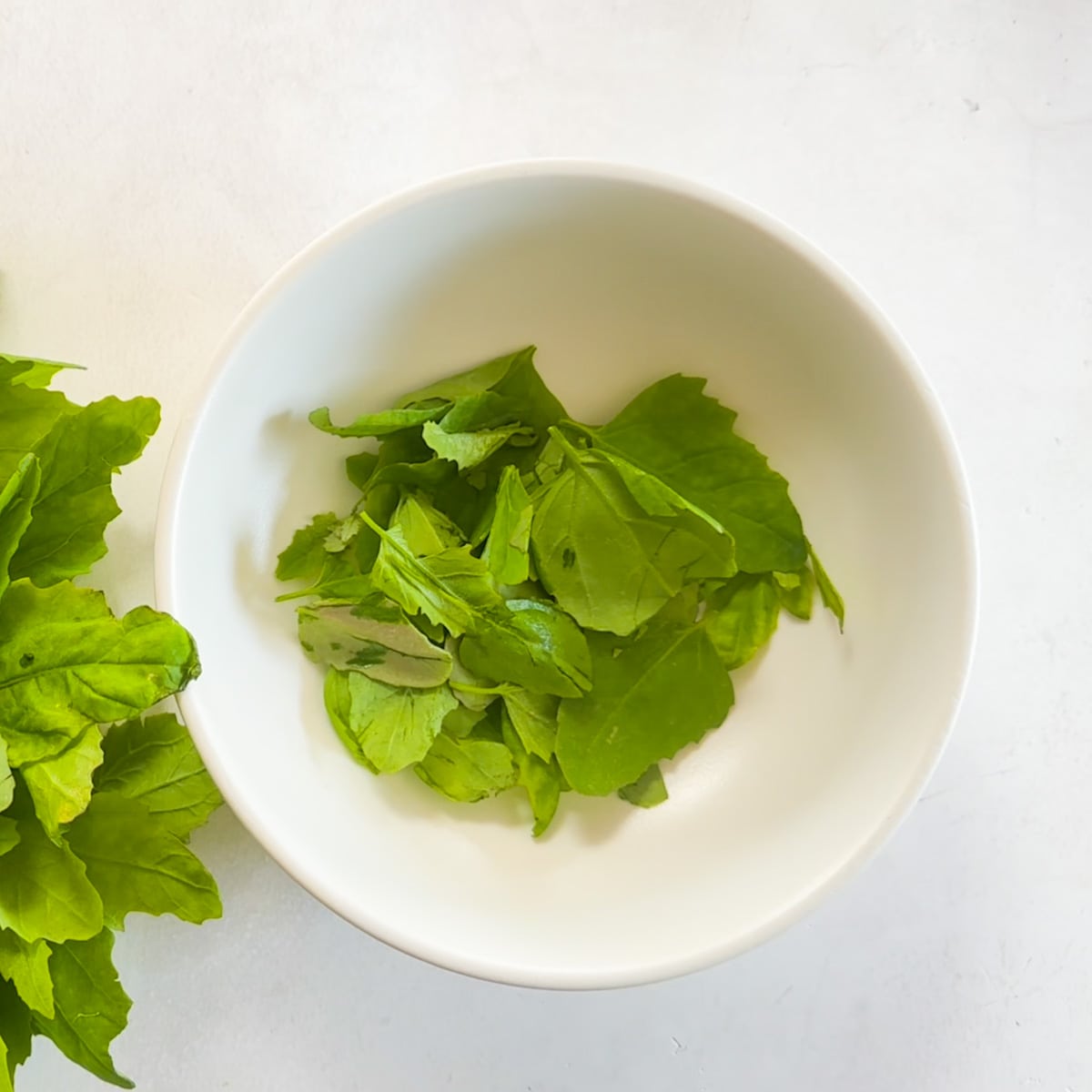
Cook the greens
Once the greens are cleaned, they are cooked together along with turnips (or radishes), green chilies, and salt until they are softened. Once cooked through, puree the greens.
In the traditional recipe, the greens are cooked in a large earthen pot on the stovetop for a long time, about 50-90 minutes. They are crushed as they are being cooked using a Mathani (a wooden whisk) to a coarse texture.
To make the cooking quicker, my mom uses the pressure cooker. You can also use the instant pot (electric pressure cooker) to cook the greens.
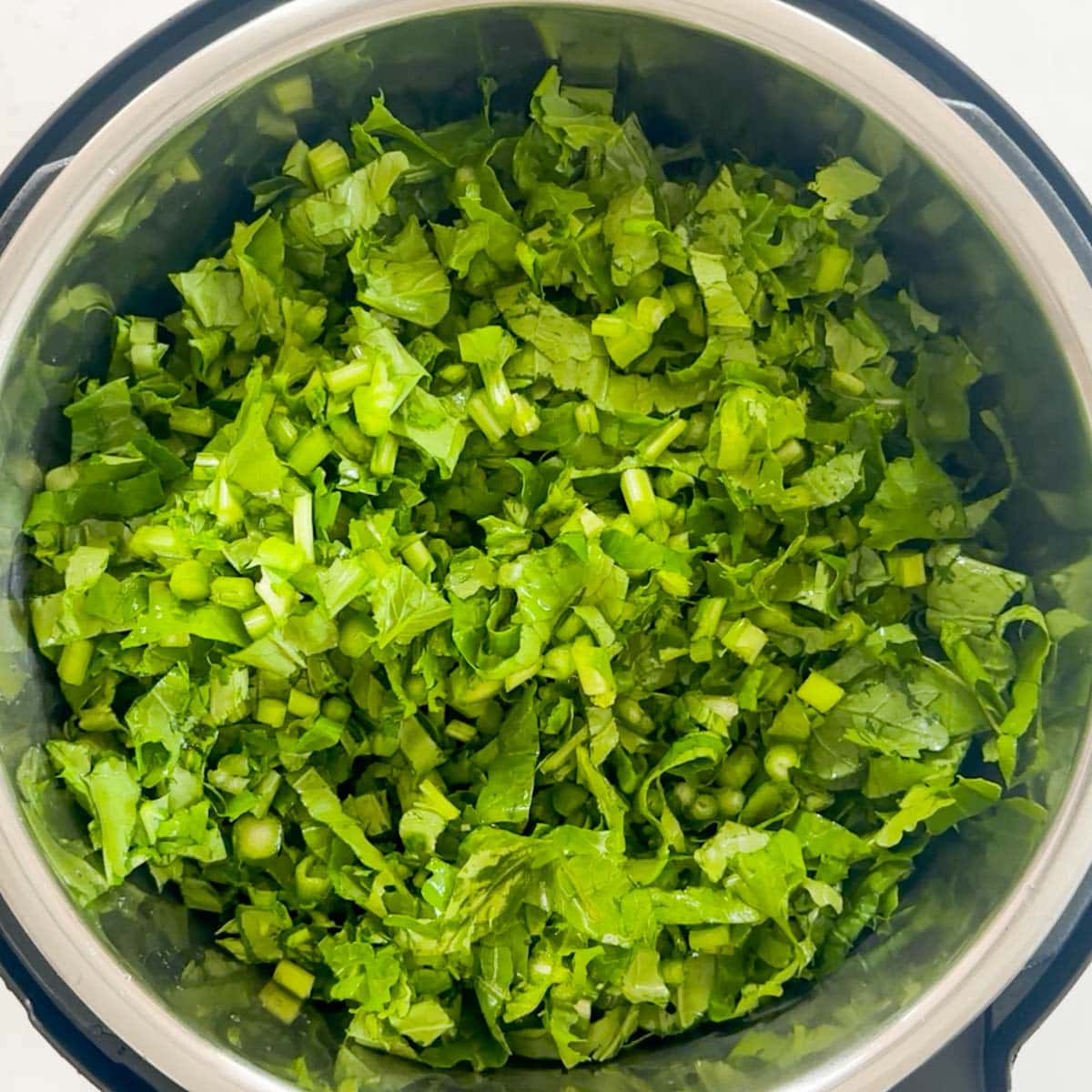
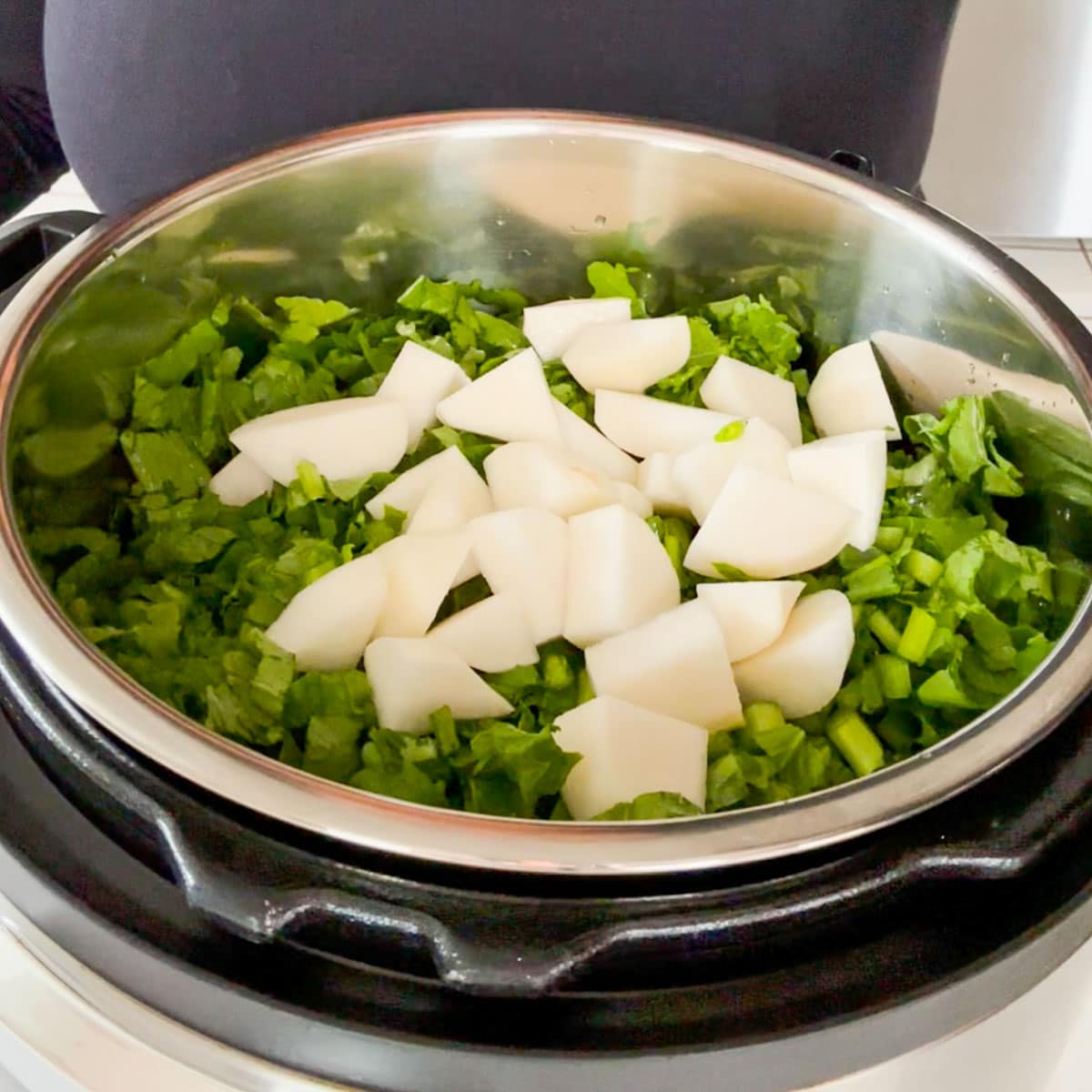
The cooked greens will be soft and dull in color. You will notice they they have shrunk to 1/4 the size of the when you filled the pot.
Blend The Greens
Then, we want to blend the greens (and turnips) to a coarse texture. For this, I love to use the immersion blender. Just pulse the immersion blender so you don’t make a complete puree and have the texture for the final dish.
You can transfer to a standalone blender if you don’t have a hand blender. Make sure to use the pulse function to have some texture in the saag.
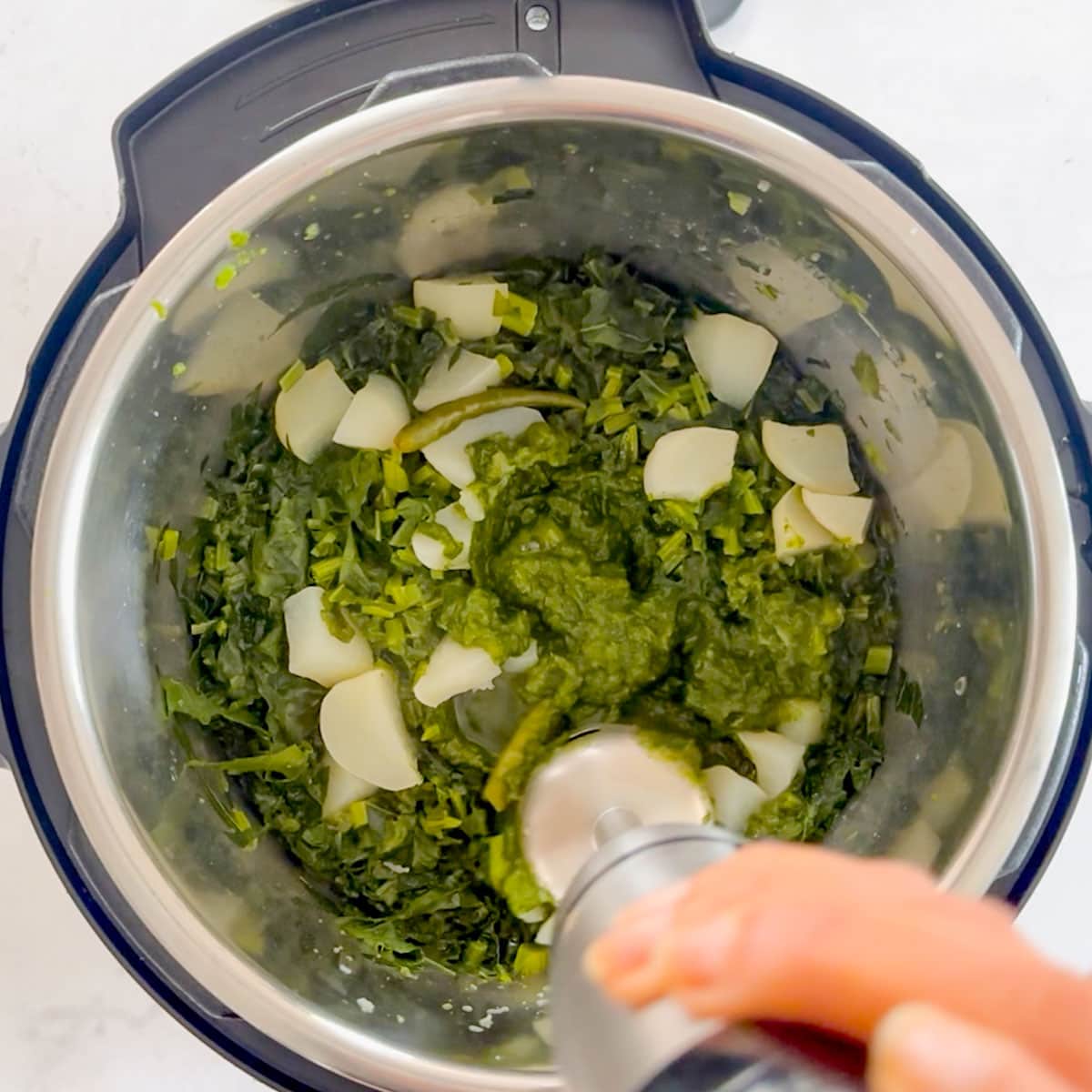
Make Tempering
The tadka is an important part of this dish. I usually start making the tadka while the greens are pressure cooking.
- Start with adding ghee/oil to a large pan. Then add dried red chili peppers. Depending on the size, you can leave them whole or break them into pieces. Then, add a pinch of asafoetida (hing).
- Then add the onions and saute until they are golden in color. Then, we add the ginger and garlic and cook until the raw aroma is gone.
- Now add the chopped tomato and spices. Cover with a lid, which helps to soften the tomatoes.
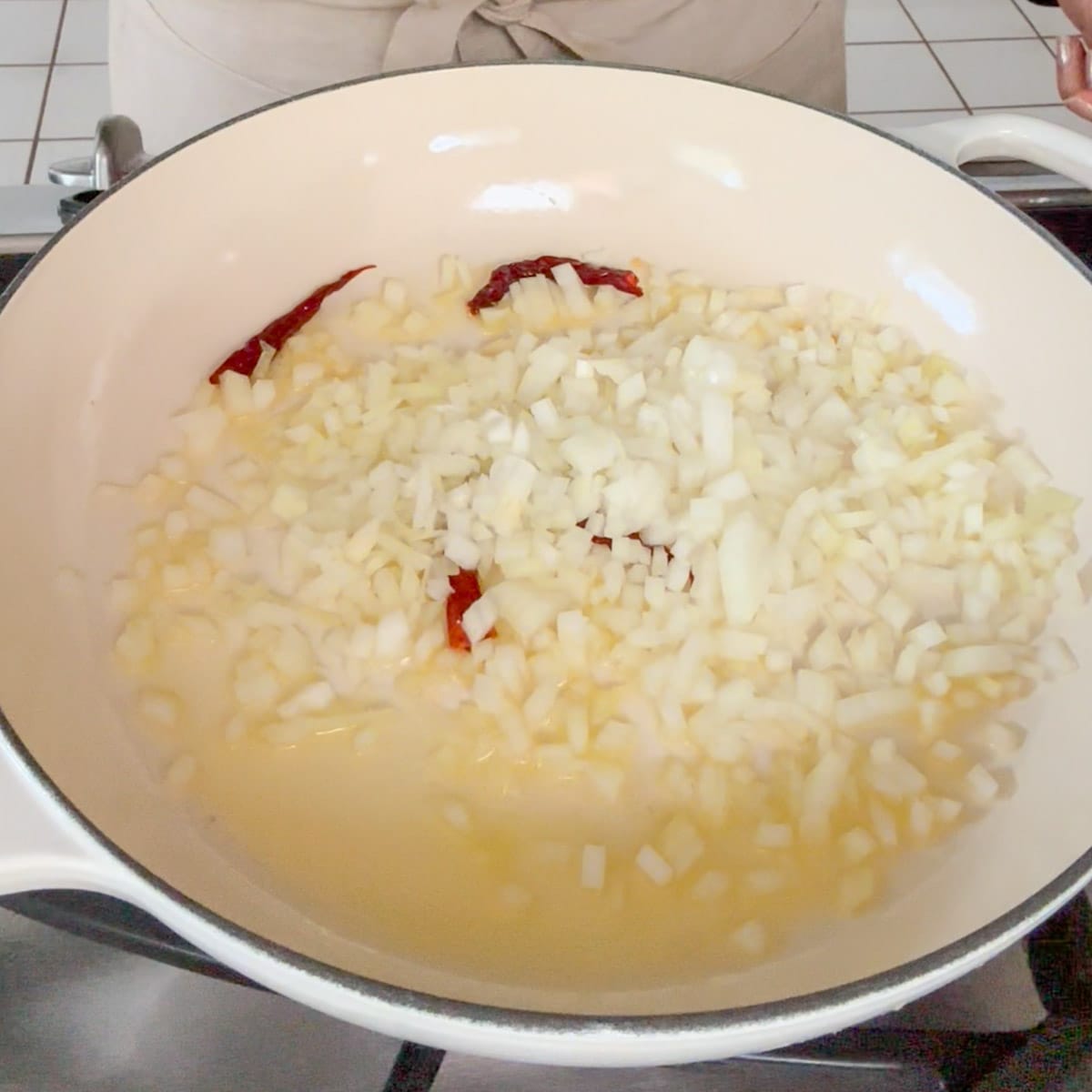
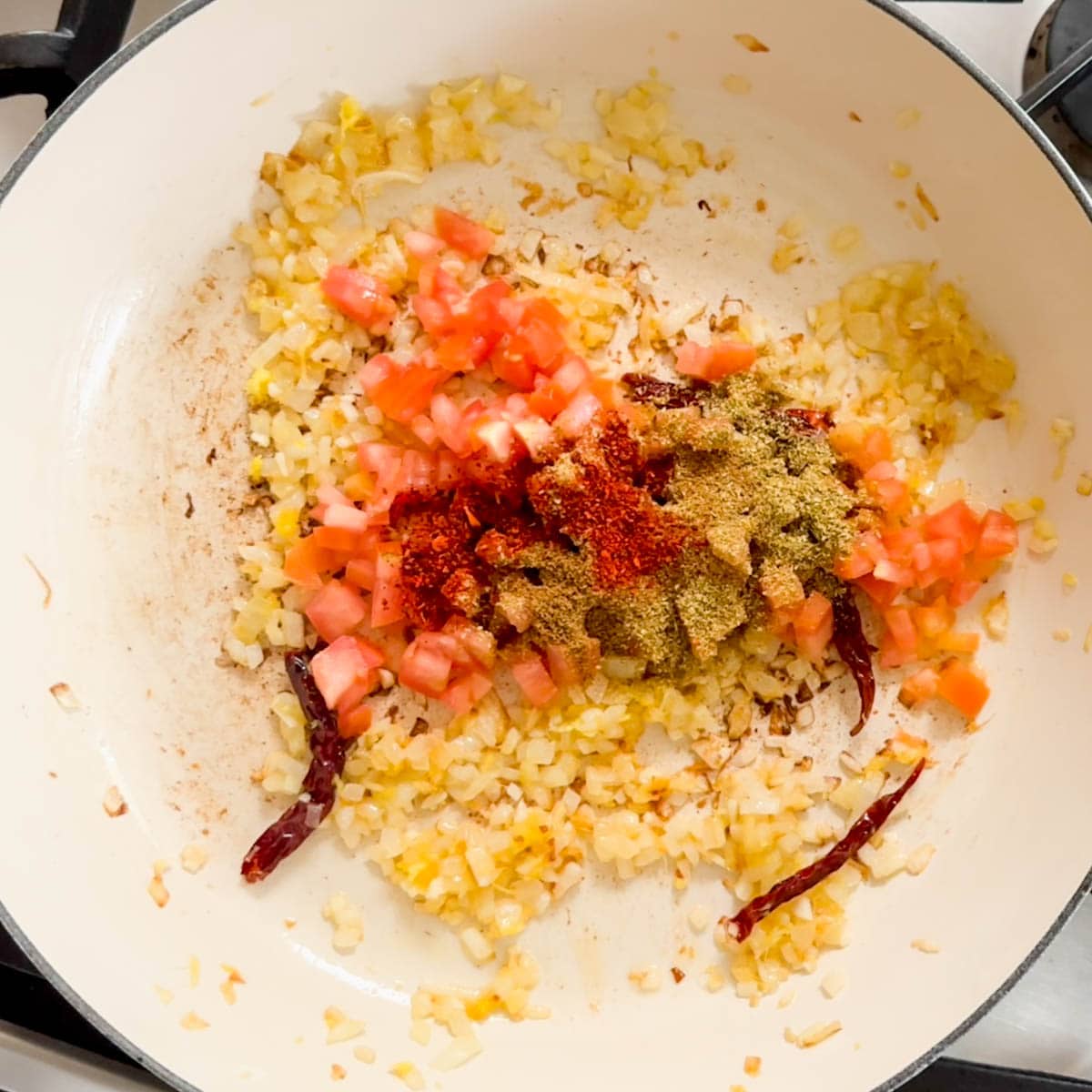
- Then, we will add the pureed greens to the pan. Now mix the greens with the tadka and cook them for a few minutes.
- Then, add the maize flour to the saag. This helps to thicken the saag. Simmer for another few minutes until the saag has thickened to your liking.

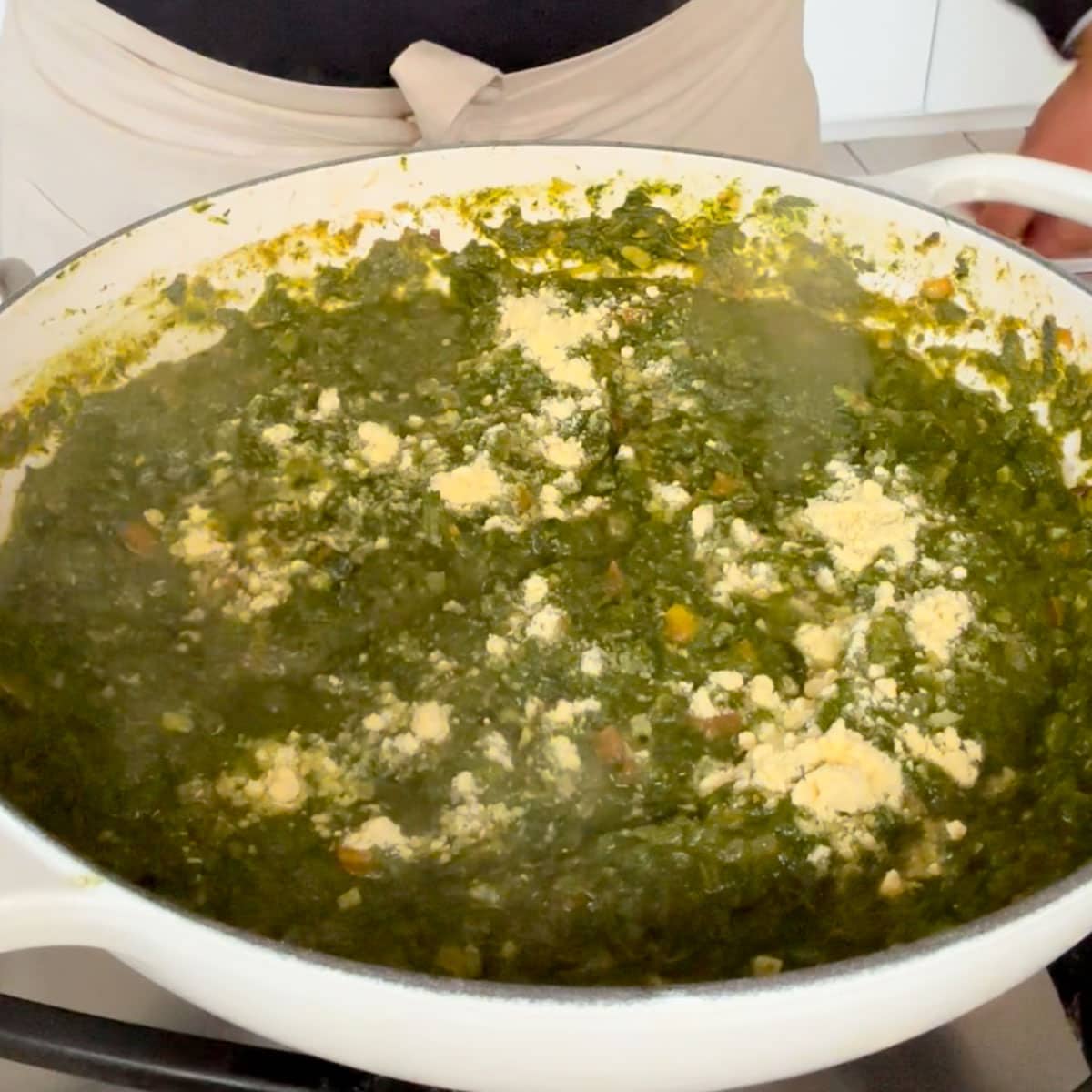
The saag is now ready and can be enjoyed as is, or you can add a final tempering of ghee of you like.
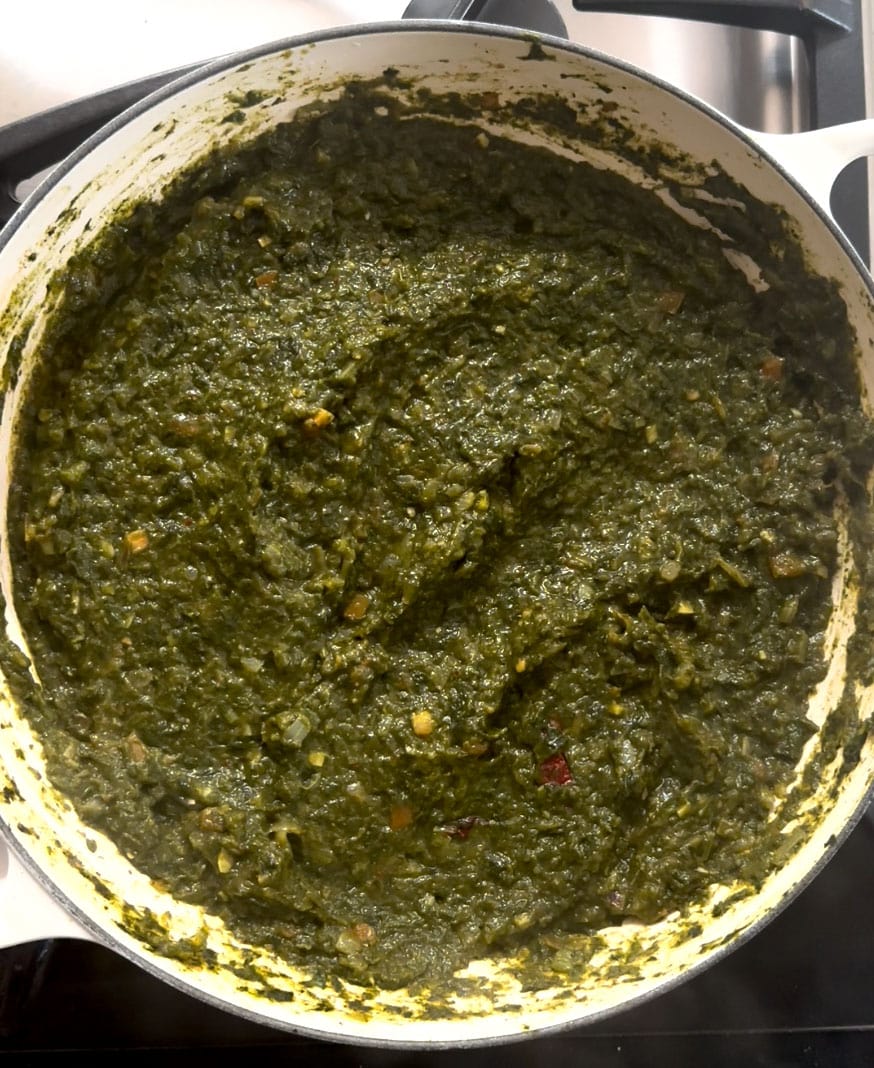
Optional Second Tempering
This tempering is completely optional but makes the dish shine. It is a simple tempering made with ghee and thinly sliced garlic pieces. I like to add a pinch of red chili powder at the end for that pop of color.
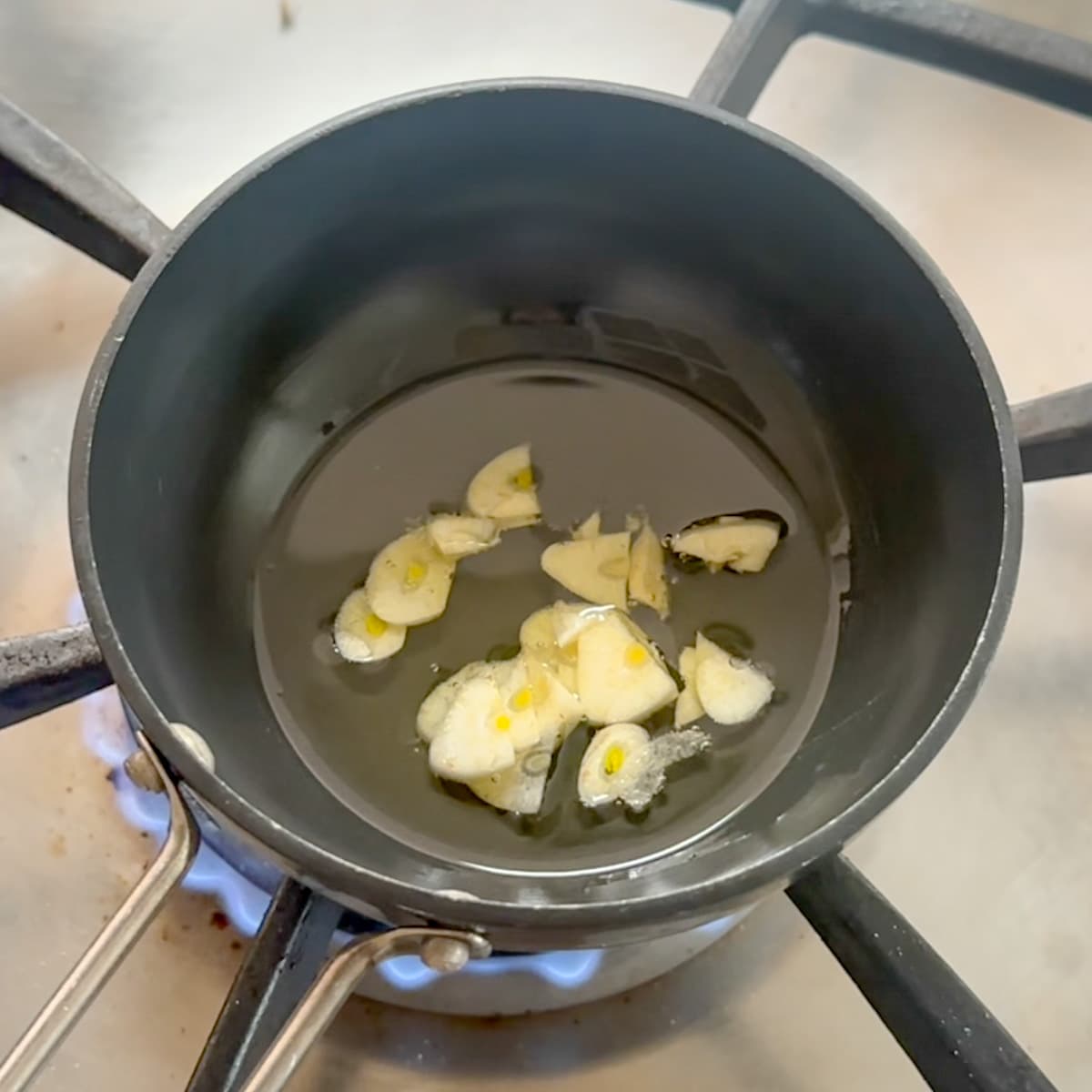

I suggest adding this tempering after you have transferred the saag to the serving dish.
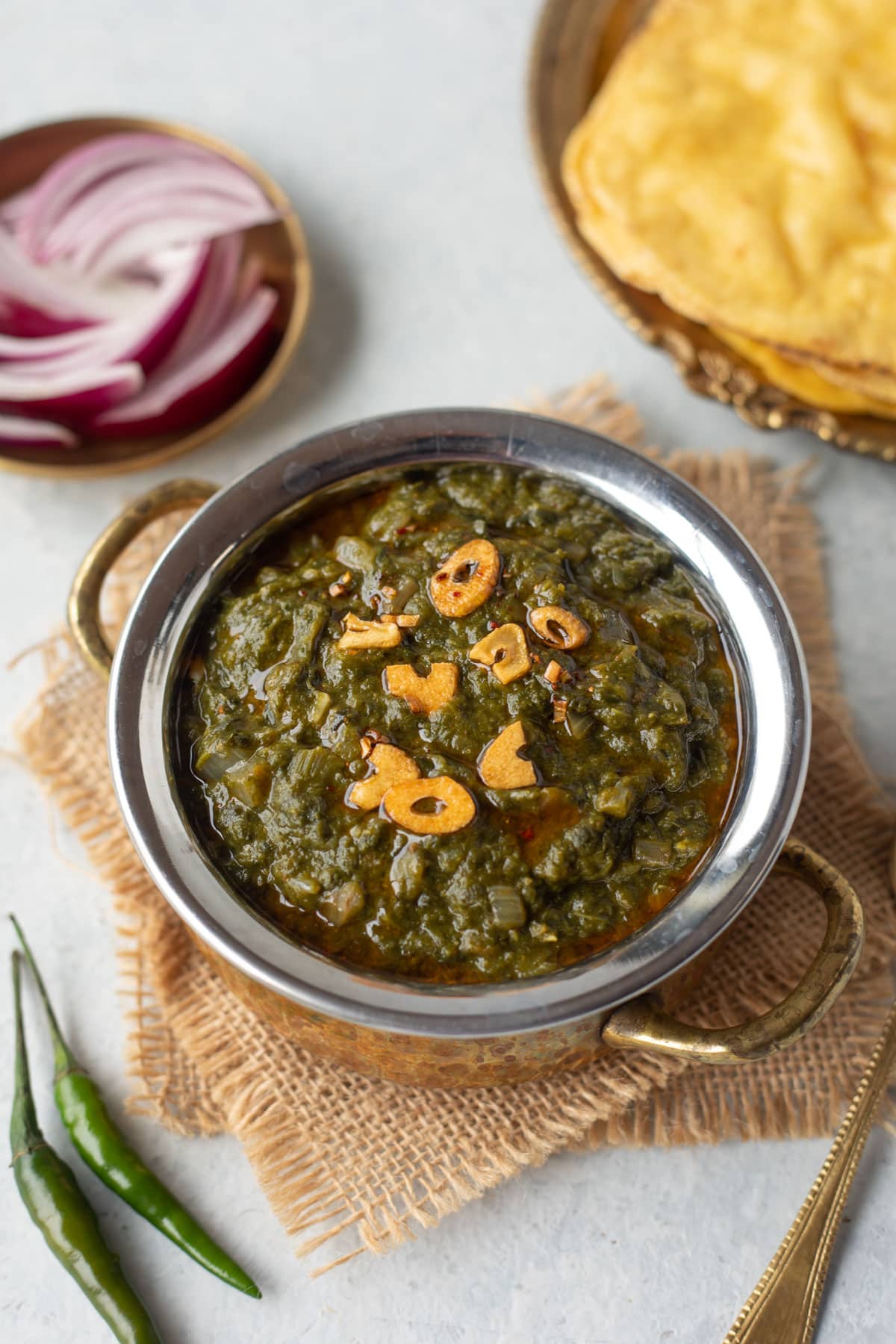
Pro-Tip for Amazing Saag
Cooking Greens: Make sure to cook the greens well. The color of saag is usually dull, not bright green, as they are cooked for a longer time.
Texture: I highly recommend not pureing the greens smoothly and giving the saag a coarse texture.
Tempering: The tadka adds a lot of flavor to the saag, so don’t skip it. Some people add onions, ginger, and garlic while cooking the greens. However, the flavors are better when these aromatics are sauteed in ghee.
Maize flour: Don’t skip adding the maize flour, as it helps thicken and bind the saag. If you don’t have maize flour, you can use besan/gram flour.
Consistency: Saag has a thicker consistency compared to palak paneer. Also, note that the saag thickens as it sits. So, you might need to adjust consistency when serving. Add hot water to the saag to adjust consistency to your liking.
Make it vegan: Replace ghee with a plant-based oil of your choice.
What to Serve with Sarson Ka Saag?
In North India, sarson ka saag is served with makki ki roti, a dollop of white butter, and jaggery. Sliced red onions, radishes, and pickle are served on the side too. I also like to serve a glass of sweet lassi along with this authentic Punjabi meal.
Makki ki roti is a flatbread made with maize flour (fine ground yellow corn meal). You can also eat saag with roti or naan, but to get a real authentic meal, do give makki ki roti a try.
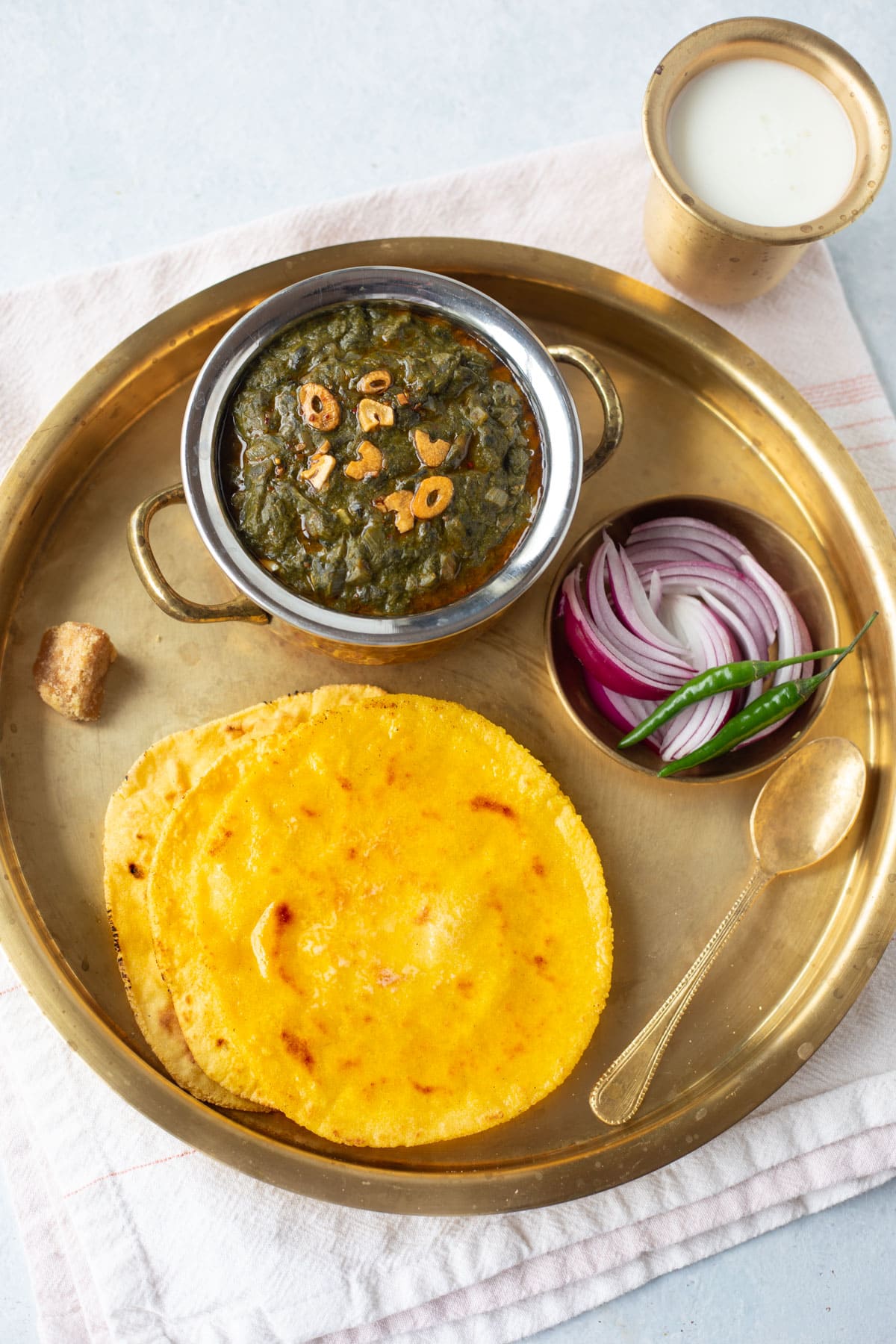
How to Store Saag?
Leftover saag can be stored in the refrigerator for up to 3 days. For longer use, I suggest freezing the saag. See details below.
I recommend reheating leftover saag in a pan or microwave. As saag thickens when stored, don’t forget to adjust the consistency by adding hot water to the saag.
Can You Freeze Sarson ka Saag?
This Saag is a great recipe that can be prepared ahead of time for storage. My mom does this too.
I like to cook and blend the greens. Then, let them cool down completely and store them in freezer-safe containers in small portions that you will enjoy for one meal for the family. You can store these in the freezer for up to 3 months.
When ready to enjoy, defrost in the refrigerator overnight. Then prepare a fresh tadka and mix the greens with it. This makes the saag feel like it was just cooked.
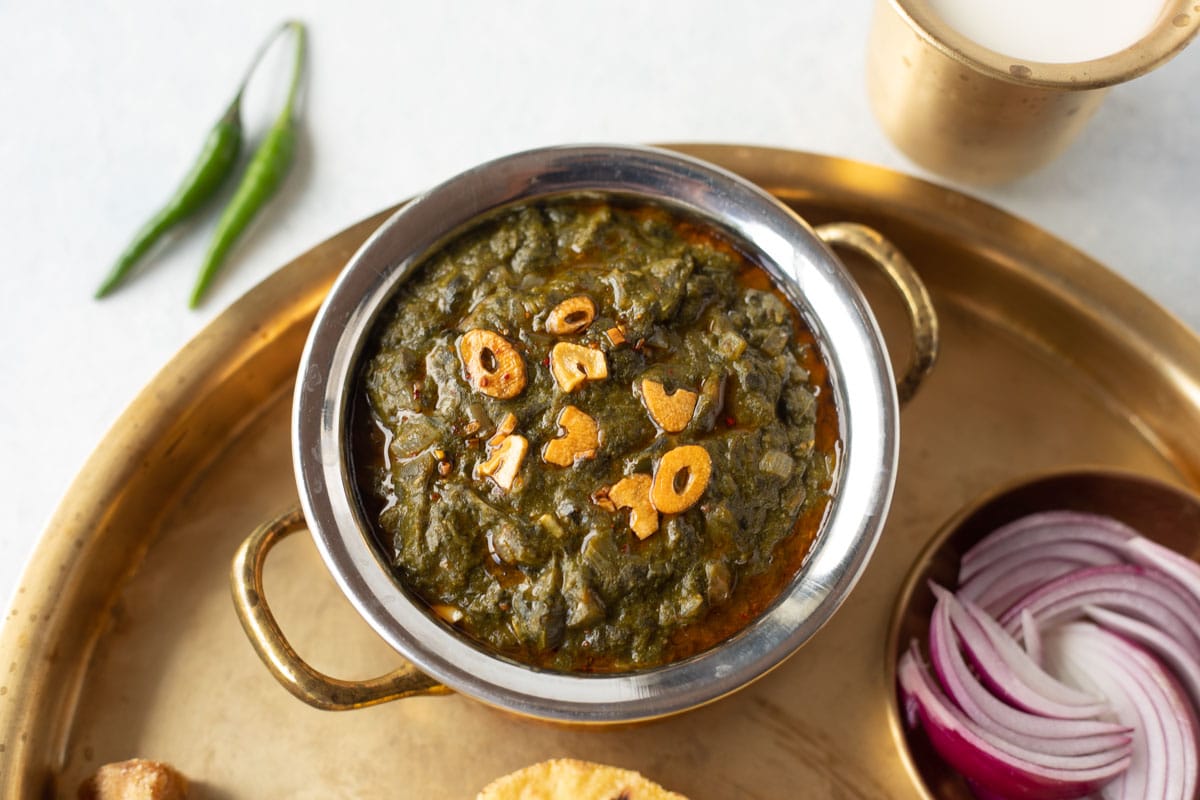
Common Questions
You can easily double this recipe if you want to make extra to store for later. You will need a larger cooking pot or pressure cooker. If all the greens don’t fit the cooker at once, you can turn on the heat and let them wilt a little, then add more greens.
The saag is supposed to have a peculiar, mildly bitter taste. However, it is not supposed to be very bitter. The turnips or radishes, when cooked along, balance the flavors of the mustard greens with their sweetness. Use fresh, tender mustard and other greens for a flavorful saag. Also, make sure not to overcook onions or ginger/garlic, which can sometimes give a bitter taste.
I hope you enjoy this family favorite, Sarson ka Saag. Don’t forget to share how it turns out!
Baingan Bharta (Roasted Mashed Eggplant)
Punjabi Kadhi Pakora
Aloo Paratha
Punjabi Rajma – Instant Pot & Stovetop (Red Kidney Bean Curry)
Instant Pot Dal Makhani (Madras Lentils)
Instant Pot Chana Masala (Punjabi Chole Masala / Chickpea Curry)
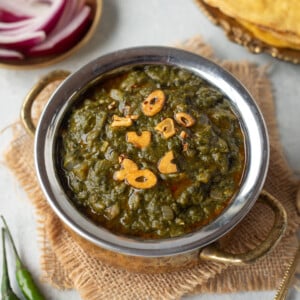
Sarson ka Saag (Authentic Punjabi Saag Recipe)
Video
Ingredients
- 370 grams Mustard (Sarson), finely chopped, leaves and soft steams, 2 bunches
- 250 grams Mixed Greens, (bathua, spinach), finely chopped
- 2 small Turnip or Radish, peeled, rinsed, and cut into small pieces, about 65 grams
- 2-4 Green Chili Pepper, optional, adjust to taste*
- 1/3 cup Water, (use 1 cup for stovetop pot method)
- 1 teaspoon Salt
Tempering
- 2 tablespoon Ghee or Butter , or use oil for vegan
- 1/8 teaspoon Asafoetida (Hing)
- 2 Dried Red Chili Whole
- 1 1/2 cup Onion, finely chopped
- 1 inch Ginger , grated
- 8 cloves Garlic , minced or finely diced
- 1 Tomato, diced, about 100 grams
- 2 tablespoon Corn meal (Makki ka aata), fine ground, also called maize flour
Spices
- 1/2 teaspoon Red Chili powder , optional
- 2 teaspoon Coriander powder (Dhaniya powder)
- 1/2 teaspoon Cumin Powder
Second Tempering
Instructions
Prepare the Greens
- Cut the thick hard stems of the mustard greens. Wash all the greens thoroughly and chop them.
Cook the Greens
- Stovetop Pressure Cooker Method: Add all the greens to the pressure cooker along with turnips, green chilies, and salt. Add 1/2 cup water. Cook for 2 whistles on high heat, then let the pressure release naturally.
- Instant Pot Method: Add all the greens to the pressure cooker along with turnips, green chilies, and salt. Add 1/3 cup water. Close the lid with the vent in the sealing position. Pressure cook on high for 4 minutes, then quick release the pressure manually. followed by natural release.
- Stovetop Stockpot Method: Add all the greens to the pressure cooker along with turnips, green chilies, and salt. Add 1 1/2 cup water. Cook for 40 minutes partially covered, stirring intermittently until the greens are well cooked.
- While the saag is cooking, make the tadka.
Blend the Greens
- The greens and turnip will be cooked and soft by this time. Their color will be dull green. Using an immersion blender, blend/pulse them to a coarse texture. You don't want to make them completely smooth and pureed. Alternatively, you can also use a mathani, which is the traditional way to mash the greens. It will take more time and effort.
Tempering/Tadka
- Heat a large pan on medium-high heat. Add ghee and let it melt. Add the dried red chilies and asafoetida.
- Add the onions and saute them for 6-8 minutes until they turn golden.
- Add the ginger-garlic and cook for another minute.
- Add the tomato and spices (chili powder, coriander powder, and cumin powder). Stir and cover with a lid for 3 minutes, so that the tomatoes soften. Remove the lid and cook for another minute until the ghee/oil starts oozing from the sides.
- Add the saag to the tadka and give it a stir. Simmer for 5-6 minutes while stirring frequently, so the saag does not stick to the bottom of the pan.
- Add maize flour (makki ka aata) to the saag. This will help to thicken the saag. Mix well and cook for another 5 minutes. Add hot water if needed to adjust consistency.
- Once the saag has thickened to your liking, turn off the flame.
- Sarson ka Saag is ready to be enjoyed. Serve it hot topped with ghee or white butter along with makki ki roti.
Optional Second Tempering
- This tempering is completely optional but makes the dish shine. Heat ghee or oil in a small pan. Once it is hot, add the sliced garlic and cook until the color of the garlic changes to golden. Then turn off the heat. I like to add a pinch of red chili powder at the end for that pop of color. I suggest adding this tempering after transfering the saag to the serving dish.
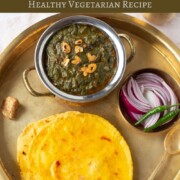
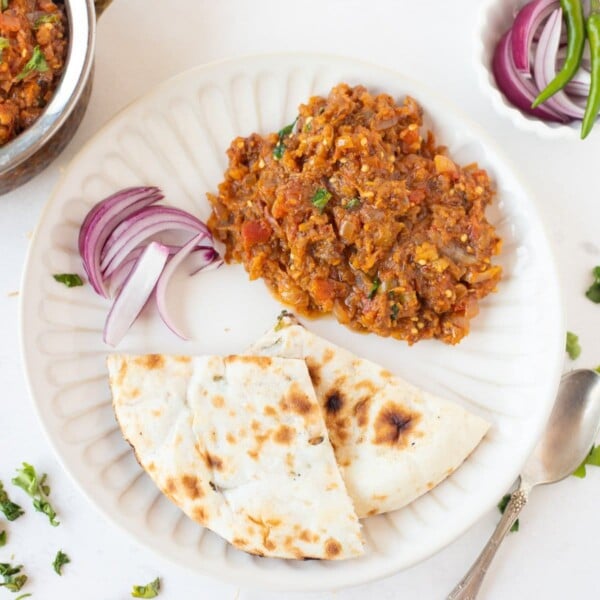


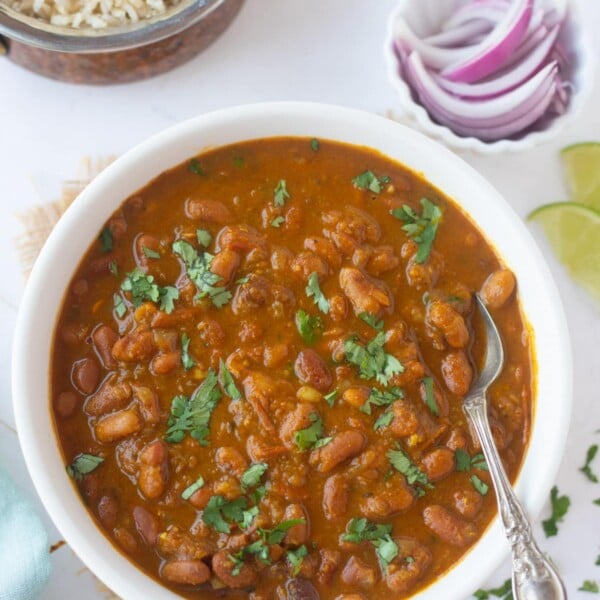
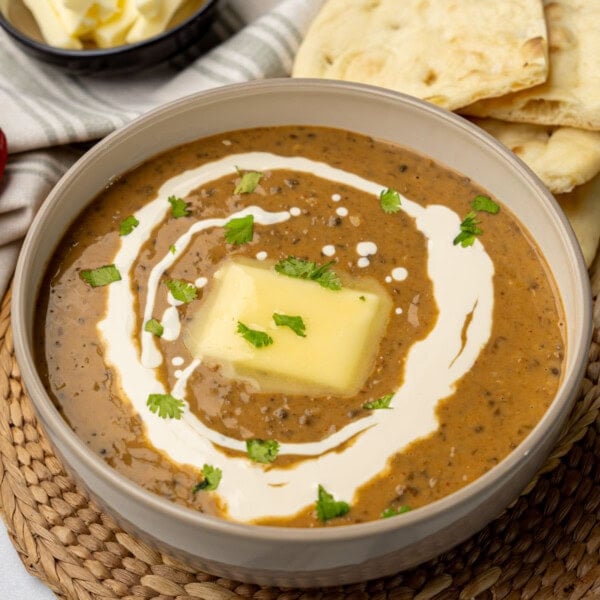

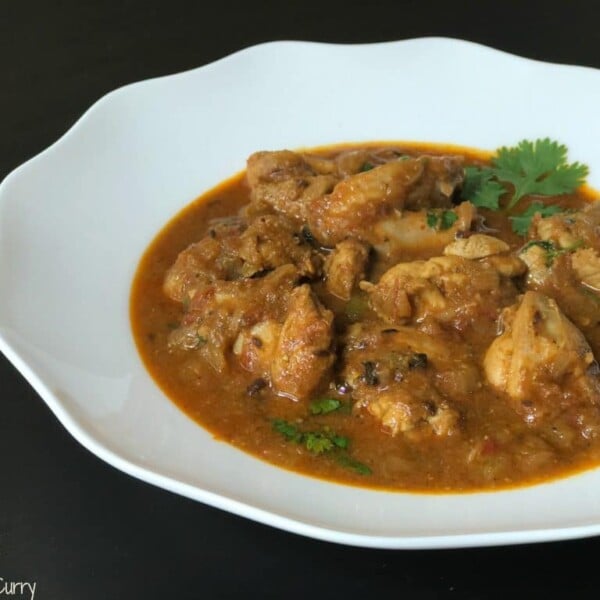

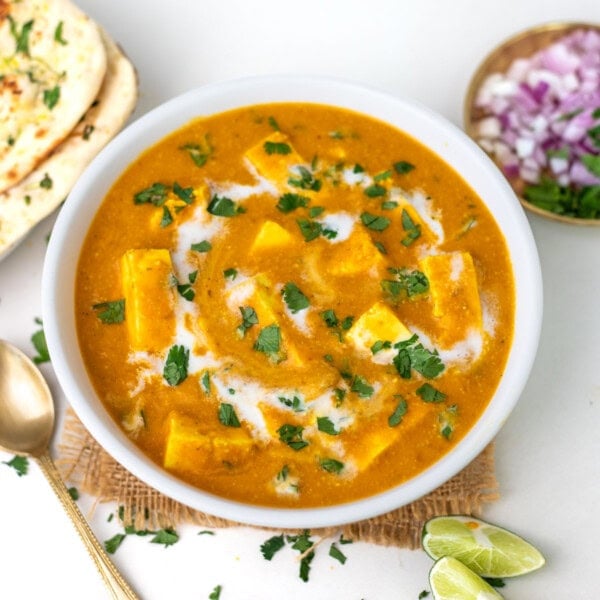
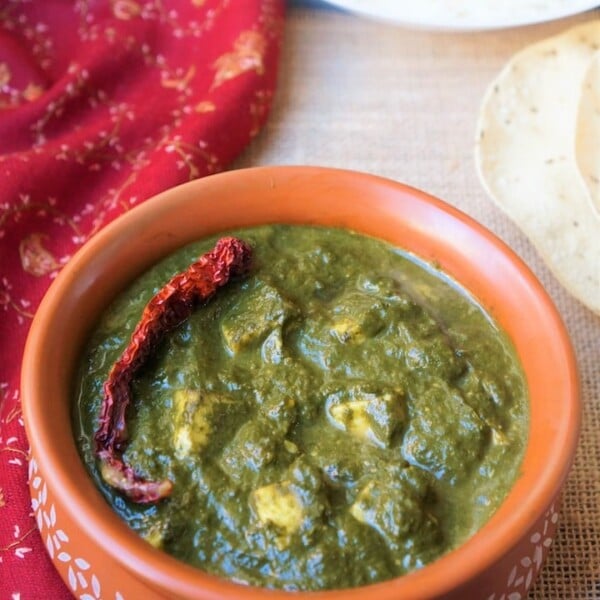








I now going on to 82, love to start my day with you. I tell my friends I am taking Meeta’s excellent Culinary Course.
Hi Donna – So happy to hear you are enjoying the recipes. Feeling grateful to have you as a reader 🙏
I haven’t tried making this recipe yet (so no evaluation) but I want to try leaving a comment:
I notice that you mention bathua in this post. I grow bathua (organic, of course) in my backyard garden and, although it may not be in traditional Indian style, I live on it for all types of recipes that use greens all summer long. I also share it (for free) with anyone interested in trying it.
If you live in NY (southern Westchester county) and you want to give it a try, just let me know! It’s February now so nothing is up yet but it’s a hearty plant and I can always rely on it coming up (with very little effort on my part. 🙂
Hi Roberta – I wish I lived closer to you, but I am in California. It is amazing that you grow fresh veggies in your backyard garden. I hope you enjoy the saag.